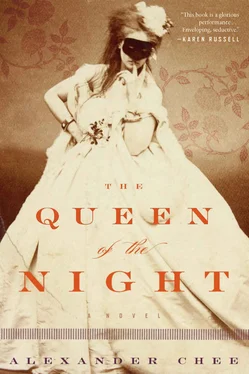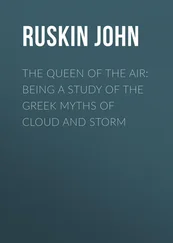I arrived at the Tuileries in the early fall of 1868, a girl of seventeen, there from the Saint-Denis convent to work as one of the maids in the palace basement wardrobe, a grisette. The name means little gray one, or gray girl. I liked the word because it made me feel as if I’d become a shadow, working as I did in the basement of the Tuileries and sleeping in a small room in its eaves.
L’Impératrice, that was the word for empress, and there was just the one.
That word stayed in the air a little after it was said, a kind of glittering dark omen. The guards said it as she made her way through the crowd, or we said it in a fierce whisper, a signal to stop what you were doing and throw yourself to the ground in her general direction. Once I heard it, every moment I was not on the ground was one in which I felt my life might be forfeit. This dismayed her, I believe, though, of course, it was done to please her. She never said it — even the Empress, I think, feared this word.
The ladies of her court wore her badge on their left shoulder, tied there with a ribbon. Three wore her portrait, painted in miniature, circled in diamonds — these were her most powerful, the most senior: the Duchesse de Bassano, Princesse d’Essling, and Madame Murat, widow of Admiral Murat and Gouvernante des Enfants de France — her title made me think of her as the ruler of a small kingdom of French orphaned children, bordered in sorrow. The other nine wore her monogram, diamond letters on a black enamel background: I for Impératrice, E for Eugénie, and an I stepping through an E, as if someone had plunged daggers into the E from above and below.
She could not choose her ladies-in-waiting. Some were her friends, but many were not. Two were with her at all times for a week at a time in Paris, a month if she went to the country. Pepa, though, she could choose. Pepa belonged to her.
Pepa was the mistress of Her Majesty’s wardrobe. A fellow Spaniard, she was squat, ugly, fierce, and strong, brought by Eugénie to Paris from Málaga. She might have been pitiable but for the rages she used to enforce her ways. If beauty didn’t make you good, Pepa was proof ugliness didn’t, either. She was assisted by two sisters, the daughters of the governor of the Château de Saint-Cloud. The governor had once been the Emperor’s jailer, and his appointment, and that of his daughters, was meant to repay the man for the trouble the Emperor had made for him by escaping from his jail. But obeying Pepa offended the sisters, and as there was something each of them would not do, a girl was needed who could not refuse.
So it was I came to the Tuileries.
I was known to them as Sidonie, from the orphanage of the Legion of Honor of Saint-Denis Convent, chosen for this work as I was small, young, quick, and believed to be mute; the chamberlain felt it best to find someone incapable of speaking back to either Pepa or the sisters. I undertook my responsibilities gladly, eager to confirm for them that they had chosen well.
I quickly proved handy at climbing inside the dumbwaiter and wrangling the dress forms into place without either tearing the silk swaths of the enormous skirts or dirtying them on the walls of the chute. The skirts or the bodices or both were often jeweled, sometimes took a month to make, and were never washed — you couldn’t clean something studded with diamonds in water and soap.
The Empress wore during the fall and winter, the high season of the balls, as many as four dresses in a day, and the single, finest, most expensive one was always for the New Year’s ball. The seconds, as they were known to us, once they’d been worn, were often stripped of their gems and given out to the poorer relations of ladies-in-waiting or sometimes, if it was not too expensive, one would be given as a present to a favorite servant.
Someone unlikely to wear it in her presence.
And so we took great care with each dress before she wore it, as it was hers, and then great care afterward, in case it was to be one of ours.
The dressmaker’s forms were made just to the size of her and she was measured every season for them. One was sent up dressed, the other empty for the dress she’d take off. When the door to the lift opened, there were always the two dummies side by side, the one bare, the other in the recently quitted dress or gown. They looked to me like two headless women, and it always gave me pause. Given how much the Empress worshipped her forerunner, Marie Antoinette, I can’t imagine she didn’t think of it. But Eugénie was Spanish, and Louis-Napoléon not quite French, either. There was not much French in him or any other Napoléon, for that matter. That would mean many things in the course of their lives, but I think, most of all, it meant they didn’t entirely understand how it was with France and her rulers and how it had always been, how it might always be.
§
From my arrival, I was concerned almost entirely with Her Majesty’s furs. They were heavy, and even if well cured, the animal musk of them made the air of their room thick and close. This was where Pepa and the sisters refused to go most often. These were not given away like the gowns, and as if they resented this fact, Pepa and the sisters ignored them all the more.
My French was of a very odd kind at this time — I knew curses and sexual positions, and how to ask for a drink, and then a few more words from lyrics learned for the tenor. At the convent I had added prayers and psalms, but in written form only. Of what I learned here, I often knew neither how things were said nor what they sounded like, and I learned as I could by listening.
When I was presented to Pepa and the sisters on that first day, for example, I understood very little of what they said to me. Pepa’s French was thickly accented by her Spanish in a way I found charming; it would be the only thing I ever found charming about her. The very stout Spaniard and the two slender, quiet French women seemed at something of a loss when I only nodded to everything they said but, of course, this was the loss the chamberlain had in mind, had even hoped for; when the chamberlain indicated that I was mute, they stared, as if it were something they could see. They then walked me through the basement kingdom, showed me the dress dummies, the boxes of pins, the dumbwaiter, the bell that would ring for me, enunciating everything carefully. And then they brought me to the room where the furs were kept. Pepa gestured with a sideways grin to me. I couldn’t tell the source of her pleasure, exactly. I could only think it was because her time in this room was done as mine began.
A list of the furs the Empress abandoned when she fled the Tuileries was published in the British newspapers shortly after the end of the Empire.
One Swansdown cloak, lined with Silver Fox.
One black velvet mantle, trimmed with Marten Sable.
One black velvet circular cloak, lined and trimmed with Chinchilla
One black velvet pelisse, lined with Weasel, with Sable collar.
One otter skin cloak.
One blue Cashmere opera cloak, lined with Swansdown.
One black Cashmere opera cloak, lined with Swansdown.
One hunting waistcoat, lined with Chinchilla.
One black silk boddice, lined with Chinchilla.
One grey silk boddice, lined with Chinchilla.
One Marabout muff.
One Sable muff.
One Silver Fox muff.
One Ermine muff.
One Otter muff.
One Otter’s Head muff.
One Marten Sable boa.
One collar of Sable tails.
One collar of Marten Sable heads.
One pair of Chinchilla cuffs.
One pair of Silver Fox cuffs.
One green velvet wrap, lined with Canadian fur.
One carpet of Thibet Goat skin.
One white Sheepskin carpet.
Читать дальше












